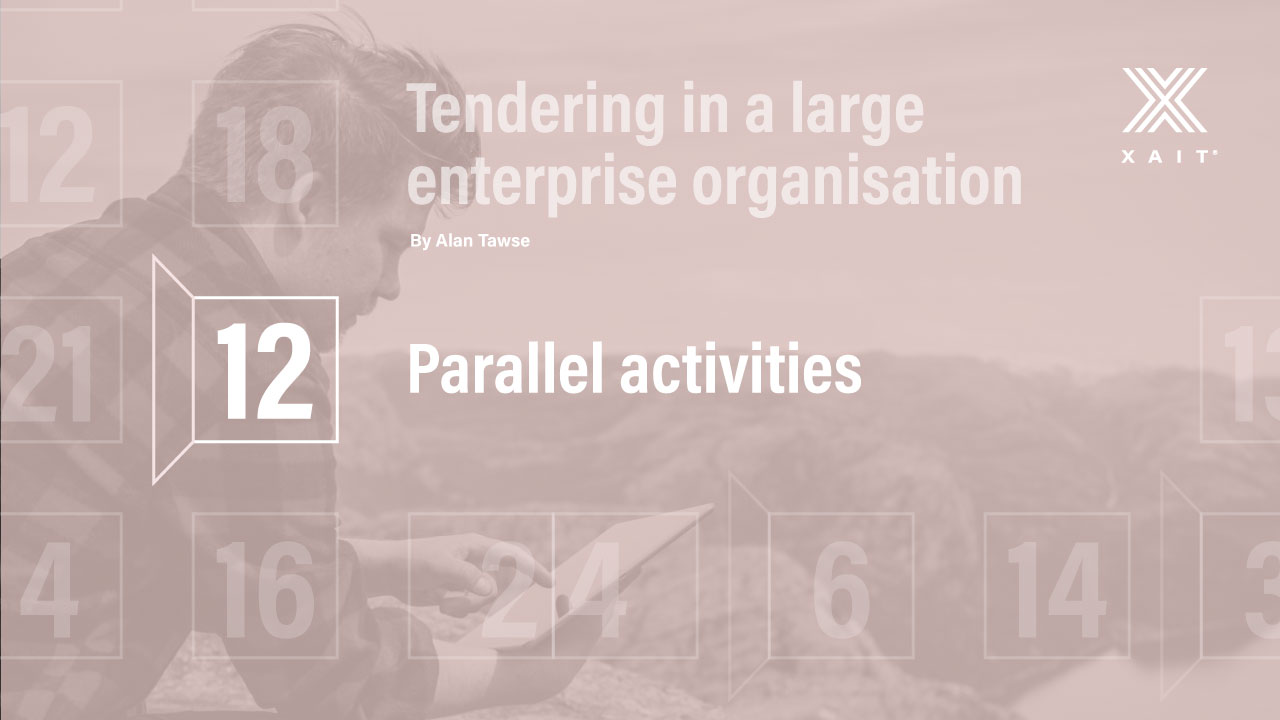
Parallel activities
11.12.2020
-4 min

Software
LET'S TALK!
We offer software that makes you win big and ultimately gives you the work-life balance you deserve.

XaitPorter
Co-authoring and automation solution for complex documents

XaitCPQ
Quickly and accurately price combinations of interdependent products and services
XaitProposal
Guided proposal creation for comprehensive, winning proposals
XaitRFI
The smarter way to respond to RFIs, DDQs and security questionnaires
XaitWebProposal
The easiest way to create interactive and custom mini-websites

XaitAI
The X factor for analyzing and writing winning bids and proposals
Industry
OUR SOLUTIONS BY INDUSTRY
Do you have a question about your business vertical?
Resources
RESOURCES
Discover all our Xaiting resources!
About us
LET'S TALK
We can challenge mindsets and make significant changes to the way people interact

Alan Tawse
11.12.2020
-4 min

In larger tenders, production of the bidder's submission is normally a multi-disciplinary activity. It is not uncommon to have several individuals or groups working in parallel with the writing team, producing important material that will form part of the finished submission. Typical examples might include some of the following:
It is important to recognize where and how these activities fit into the overall time plan. Care should be taken to also monitor progress of any other persons or teams working in parallel with the writing team on these other tasks/material to be included in or with the submission.
The size and format of any output should be planned for, in order to avoid any last-minute surprises. It can be helpful to try to produce and review a draft of their material or at least an example output, to try to identify whether or not there might be any issue or additional work needed once their work is finished. The format in particular may need some thought. For example, technical drawings may need special packaging like cardboard tubes, or product samples may need special containers.
This may produce raw data or information that requires formatting before it can be incorporated into the tender response. The person delivering the information may think that they have completed their assignment, but that does not necessarily mean the product they deliver is ready for use.
Some graphics may be provided in an uncommon format that is difficult for most non-technical users to display because they don't have access to the necessary software. These need to be identified in sufficient time to allow for conversion into a practical format or some other solution.
As pricing is often the most single important part of the submission, it needs to be reviewed, checked and formatted with the same care as any other part of the submission. However, this is often one of the last elements to be completed, so any work that can be done in advance to prepare the pricing layout and formatting will help minimize the pressure when it is delivered
This portion of a tender submission usually involves the bidder’s legal team, who will document any exceptions or qualifications they want to submit. This information may be prepared and maintained in their own internal legal or contractual system or format. The tender instructions often specify a particular format for this content, which may mean some additional work for the tender support person or team.
This may produce some information from specialized lab equipment or computer program in a special layout or format. If so, it is likely that some additional work may be needed to prepare the information for inclusion in the tender.
This often requires the use of specialized software to produce Gannt chart type displays. These tend to contain a lot of very detailed information and develop into non-standard page sizes, making them more difficult to integrate seamlessly with the rest of the tender submission. The tender support team should plan for how to achieve this by staying updated on the progress and what the finished charts are expected to look like. Then they can assess whether these can be included in standard page size or fold out format, or need to be referred to and provided as separate files or documents.
In the event that some parts of the scope of work cannot be provided directly by the enterprise, a decision will be made as to whether to exclude this from the tender submission as an exception, or to procure this part of the work-scope from another supplier. Unless the enterprise already has a contracted supplier in place, it means they will need to perform their own procurement process, to determine who they wish to select to provide the missing goods or services.
If this means simply purchasing some products from a supplier, the costs will be built into the enterprise's cost and price modeling process. If, however, it involves the supplier being responsible for a portion of the tendered services, they will be regarded as a subcontractor and the process will be more complicated and time-consuming.
Potential subcontractors will need to become part of the tender process, understanding all of the contractual, commercial and technical terms and conditions that will apply to their portion of the work. They will need to submit their offers to the enterprise procurement team, and the internal procurement process will normally need to be completed and a vendor selected before the tender submission date. This needs to be completed in enough time, since the subcontractor's financial and technical input will need to be reviewed in the same way as the rest of the tender response and integrated into the appropriate places by the tender support team.
As the tender response is being prepared, the enterprise will follow an internal approval process to inform management about the nature and value of the opportunity, and obtain the necessary approval for their tender win strategy, commercial offer and inform about any risks, capital investment requirements, etc.
Such approval will normally be required before tender submission, otherwise it may be necessary to submit a conditional response, subject to management approval. Anything other than a short delay, with a good explanation, is not desirable as it is subject to the client's acceptance and may jeopardize the evaluation of the tender submission.

Alan Tawse
Alan has worked in the oil and gas industry since 1974 in various administrative, operational and managerial roles in the UK, Netherlands and Norway. In 1993 he joined Halliburton in Norway as country manager of their new Drilling Systems division. Following a merger with Dresser industries in 1998, he moved to Business Development where he established a BD support team providing centralised expertise for tendering, contract management, market intelligence and various BD software systems. After managing up to 200 tenders and proposals annually for over 20 years, Alan retired at the beginning of 2020 with plans to explore Norway, and spend time with family overseas, He enjoys downhill skiing in the winter, golfing in the summer and following the Formula 1 racing season throughout the year.

